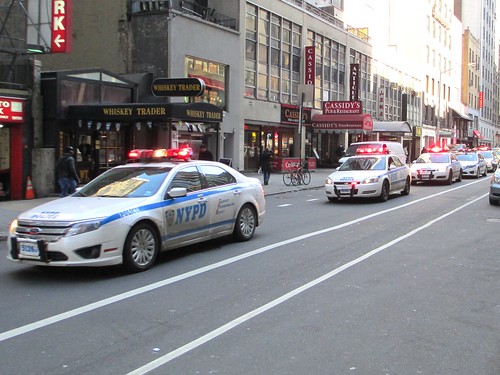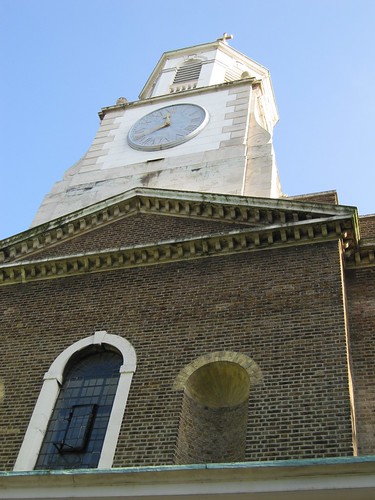It was a frustration as intense as any I’ve ever felt. I’d
just been hit as I rode across Newington Causeway, near Elephant & Castle
in South London , by another cyclist who’d
ridden fast through a red light. Yet, when I made it clear I planned to call
the police, he picked up his bike and rode off as fast as he could. A mixture
of anger and frustrated impotence welled up inside me. The other rider, I
realised, would face no consequences at all for prioritising his own convenience
over my safety.
I’ve recalled how I felt following that incident in March
2009 several times in the last few weeks as I’ve contemplated New York City ’s response to some of the
appalling tragedies on the city’s roads. New
York ’s law enforcers often seem to shrug off instances
of astonishingly poor negligent driving – including many that kill entirely
blameless people – as casually as that rider six years ago picked up his fixie
and rode off. For example, Marlon Sewell, who drove his SUV onto a sidewalk in Fort Greene
 |
| Attendees at the vigil for Victoria Nicodemus: killed on the sidewalk but, as far as Brooklyn law enforcement's concerned, hey, it's the kind of thing any of us could do. |
At a vigil at the site of the crash on December 22, Victoria ’s brothers and
a series of politicians all lined up to demand Mr Sewell be prosecuted “to the
fullest extent of the law”. I recognised anger and frustration similar to what
I felt following the crash at Elephant & Castle - though clearly, given the
crash’s gravity, theirs was immeasurably deeper and more intense.
It’s a frustration that people concerned about street safety
in many parts of the world share. UK
cycling and walking activists often express astonishment at the low level of
charges that drivers who kill or maim people in the UK face and at the apparently light
sentences facing those convicted.
Yet I also occasionally hear dissenting voices. Isn’t it ironic,
they ask, that activists who mostly doubt the appropriateness of harsh prison
sentences call for them over road crashes? Rabi Abonour, a valued member of New York ’s street safety
movement, supplied such a voice after Nicodemus’s death, writing that he was
“uncomfortable” with the calls for murder or manslaughter charges.
4. We have huge problems with criminal justice in this country. Putting more people in jail doesn't fix anything.
— Rabi Abonour (@rabonour) December 7, 2015
“We have huge problems with criminal justice in this
country,” he wrote. “Putting more people in jail doesn't fix anything.”
It’s a complaint that someone writing in the UK could also,
to a lesser extent, make, given the UK’s unusual propensity compared with other
European countries, for putting
people in prison.
Pushing for more enforcement, Rabi went on, was almost
certainly going to end up meaning more people of colour were prosecuted than
white people.
“We need to fix the racism of our criminal justice system
before we push for more felony charges against dangerous drivers,” he wrote.
The critical question is how to balance the appropriate
demand that drivers face consequences for their bad behaviour with the
understanding that the criminal justice system is an imprecise, often unfair
tool for achieving that goal.
 |
| Occasion for liberal guilt: the corner where I got into a row that ended in a driver's receiving a worryingly disproportionate fine. |
Yet those of us on the political left often, I think, misunderstand
a critical part of the criminal justice system’s role. The system certainly
exists to deter criminals and to reform those who have already committed
crimes. But it is also vital that the system expresses society’s rage at those who
violate its rules and do unjustified harm to others. There is an inevitable and
appropriate element in many criminal sentences related to exacting retribution
for the wrongdoer’s violation of the norm that members of a society should not
do unjustified harm to one another. It is a vital part of society’s valuing of
people’s property, health and lives that it should be so.
 |
| New York criminal justice is relaxed about bad driving - and people wonder how the streets end up looking like this. |
It seems to me, based on media reports, that a criminal justice
system that valued human life appropriately would indeed charge Marlon Sewell with
serious offences resulting in a prison sentence of at least a few years. Sewell’s
licence had been suspended in March and he was cited three times for speeding in
one week in November. Witnesses say he was driving too fast when he mounted the
sidewalk. He can have been under no illusions either that he was legally free
to drive or that his driving was of an acceptable standard. The system
currently plans to treat Mr Sewell’s killing of her as essentially little more
than a matter of not having the right paperwork in order.
While it is, of course, fatuous to call the crime murder – it
lacked the targeted malice for that – it can be only because the killer was a
car driver that the case is currently being treated differently from other
deaths through negligence. It is hard to imagine that if Sewell had been
driving drunk – the one type of negligent driving most US prosecutors currently
take seriously – he would be facing such minor charges.
Yet the tragedy of many criminal justice systems worldwide lies
less in how they treat people like Marlon Sewell once they’ve killed someone than
in their readiness to let matters get that far. New York City ’s authorities essentially
believe it more important that people should be free to drive around the city
as they please than that the unlicensed or uninsured should face regular checks
to prevent them from doing so. The authorities view it as more important that
traffic should flow freely and drivers’ privacy be respected than that
30-year-old Ms Nicodemus should be able to walk down a sidewalk unmolested by
speeding vehicles. It is at this stage – where a tendency to dangerous
behaviour can be detected, challenged and corrected – that the criminal justice
system should be working, in Rabi’s words, to “fix” things.
 |
| Two drivers block the bike box while a third runs a red to make an illegal left turn: scenes from a culture of consequence-free bad driving |
The logic of the existing system, meanwhile, reflects grubby
realities about US
justice that both Rabi and I would like to alter. Unfettered driving is
tolerated at least in part because it is the means of transport that has come
to seem “natural” for the US ’s
rich and powerful. Many in authority significantly underestimate driving’s
drawbacks because those who suffer the pollution, deaths and injuries are
disproportionately poor and, consequently, members of ethnic minorities. While
Mr Sewell is black and Ms Nicodemus was white, the concentration of car
ownership among the better-off means that well-off whites are
disproportionately likely to be killer-drivers. Poor members of ethnic
minorities are disproportionately likely to be their victims.
None of this is to say that those concerned about street
safety around the world should shrug their shoulders at the shortcomings of their
criminal justice systems and push for harsh punishments for dangerous drivers
regardless. It is vital, for example, that cities like New York increase their dependence on
automated cameras to detect routine speeding and right-of-way violations. Such
a move would, I have argued before, help both to reduce the problems caused by
police officers’ racial biases and to prevent appalling incidents like the
death of Sandra Bland in a Texas jail after she was stopped for a nonsensical,
minor violation. Activists should insist that in traffic enforcement, as in
non-traffic crime, law enforcement officials develop plans to detect people who
are apt to cause harm to others and seek to nudge them with minor punishments –
points on their licences, compulsory retesting or restrictions on their
licences – designed to make them address their behaviour and attitudes. Many of
New York ’s
streets are also long overdue redesigns that would encourage better driving.
It remains clear to me, nevertheless, that a driver takes on
a serious responsibility when he or she starts driving in a car. It is
impossible to believe that Marlon Sewell, after multiple run-ins with the law
over his driving, can have been unaware how serious the consequences of his
behaviour could be. As a result of his negligent driving, he has taken away
everything the 30-year-old art curator had and much that her family and
boyfriend had. The horror of the event, it seems to me, is less that people are
calling for Mr Sewell to face serious charges for his actions than that there
is such profound moral confusion over it. The New York Daily News, for example,
bafflingly quoted an apparent witness to the tragedy as largely exonerating Mr
Sewell, saying that he would have Ms Nicodemus’s death on his conscience forever.
The real villain, the piece alleged, was a bystander who, dazed after
witnessing the crash, took a bite from the pizza she had just bought.
Standing at the site of the crash on Wednesday with others,
it was both horrific to contemplate what had happened there and all too easy to
imagine. Other drivers kept venting their frustration at the slight congestion
from the vigil by honking their horns, blocking crosswalks and exhibiting the
kind of behaviour that contributes to New
York City ’s appalling street safety record. As Ms
Nicodemus’s family and colleagues talked about her, the tragedy was not only
that she was clearly a unique and talented individual but to think of how the
near-daily other tragedies on the city’s streets must be wiping out others just
as brilliant and loveable.
 |
| An installation that Victoria Nicodemus' colleagues made after her death: likely to prove an empty plea as long as bad driving is effectively ignored. |
It is obviously correct that the criminal justice system’s
biases should be eradicated. It is
obviously correct that unthinking, harsh punishments solve nothing. It is also
obviously correct that the US has relied on prison too much to solve its
social problems. In particular, the US has imprisoned far too many
young black men for drug offences that in a better-ordered society would not be
offences at all.
Yet it is equally clearly true, it seems to me, that a
system that defines Marlon Sewell’s driving on December 6 as warranting no more
than two warrants for technical violations is morally bankrupt. It is a
system that will continue to be incapable of preventing other people – mostly
poorer, more marginalised people than Ms Nicodemus – from dying. Their being
crushed on sidewalks, in crosswalks and bike lanes by drivers will then be
dismissed by the authorities as little more than an understandable slip.



























